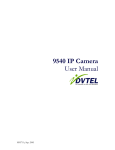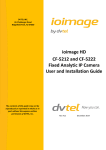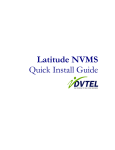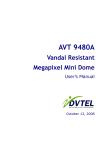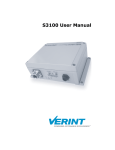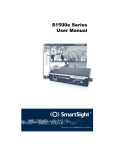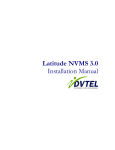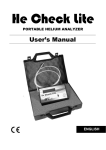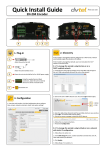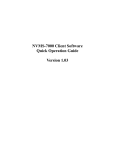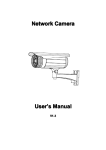Download S1700e User Manual.book
Transcript
7600 Series (Single Port) User Manual © 2004 DVTel, Inc. All rights reserved. By providing this document, DVTel, Inc. is not making any representations regarding the correctness or completeness of its contents and reserves the right to alter this document at any time without notice. Published by: DVTel Inc. 65 Challenger Rd. Ridgefield Park NJ, 07660 USA www.dvtel.com Publication date: November 9, 2004 i Table Of Contents Preface ................................................................................................................... iv Who Should Read this Manual ................................................................................v How to Use this Manual .........................................................................................v Contents ........................................................................................................v Conventions .................................................................................................. vi Related Documentation ................................................................................... vi Related DVTel Products ................................................................................... vi Support .............................................................................................................. vi Chapter 1 Overview ..............................................................................................1 About the 7600 Series .......................................................................................... 2 Physical Characteristics ................................................................................... 2 Security ........................................................................................................ 2 Video ........................................................................................................... 2 Shipment ........................................................................................................... 3 Casing Description ............................................................................................... 3 Chapter 2 Configuring and Installing the Unit .......................................................4 Configuring the Unit ............................................................................................. 5 Computer Requirements ................................................................................. 5 Setting Unit Parameters .................................................................................. 5 Creating a Point-to-Point Connection ................................................................ 7 Installing the Unit ................................................................................................ 8 Connecting to the Serial Ports ............................................................................... 8 Configuring the I/Os ............................................................................................ 9 Audio ..........................................................................................................10 Alarms ........................................................................................................11 Performing a Hardware Reset ...............................................................................11 Status LEDs .......................................................................................................12 Chapter 3 Web Interface .....................................................................................13 Getting Started ..................................................................................................14 Unit Configuration ..............................................................................................15 Serial Port ....................................................................................................15 Access Management ......................................................................................16 System Status ..............................................................................................18 Network .......................................................................................................18 Video ..........................................................................................................19 VSIP ...........................................................................................................21 Audio ..........................................................................................................22 System Time ................................................................................................23 HTTP (Webserver) .........................................................................................23 Live Video .........................................................................................................24 PTZ Controls ................................................................................................25 ii Appendix A Factory Default Configuration............................................................26 Appendix B RS-422/485 Multidrop Connections...................................................28 Appendix C DTE and DCE Connections ..................................................................30 Appendix D DHCP Support and APIPA Service......................................................33 Appendix E Audio Pinouts ....................................................................................35 Appendix F CLI Access .........................................................................................37 Network Connection ............................................................................................38 Serial Connection ...............................................................................................39 Appendix G Technical Specifications ....................................................................40 Glossary ................................................................................................................42 Index .....................................................................................................................46 iii Preface The 7600 Series User Manual presents the information and procedures for installing, configuring, and using the DVTel 7600 Series video servers. iv Who Should Read this Manual This manual is intended for managers, IT system administrators, engineers, and technicians who will use the 7600 Series units. It provides conceptual information on how to configure, install, and operate the units. This manual assumes that you are familiar with: Installation and manipulation of electronic equipment General use of computers Microsoft Windows operating systems Local area networks (LANs) and basic IP data communication concepts and practices Pan-tilt-zoom (PTZ) platforms (cameras and keyboards) Web browsers How to Use this Manual This manual contains all the information needed to install, configure, and use a 7600 Series unit. Contents The 7600 Series User Manual is divided into the following chapters: 1. Overview—Provides a brief description of the features of the 7600 Series and illustrations of its casing. 2. Configuring and Installing the Unit—Presents the configuration and installation procedures for the 7600 Series unit. 3. Web Interface—Explains how to use the web interface to configure the unit and view live video. The manual also includes the following appendixes: A. Factory Default Configuration—Lists the default parameter values of 7600 Series unit. B. RS-422/485 Multidrop Connections—Presents information regarding the 2-wire and 4-wire RS-422/485 multidrop connections. C. DHCP Support and APIPA Service—Explains how the dynamic host configuration protocol server and the Microsoft APIPA service work. D. DTE and DCE Connections—Explains how to differentiate and connect data terminal equipment (DTE) and data communication equipment (DCE). E. Audio Pinouts—Presents the pinouts for audio input/output. F. CLI Access—Explains how to access the command line interface (CLI) of the unit. G. Technical Specifications—Lists the complete technical specifications of the 7600 Series unit. A glossary and an index complete the manual. v Conventions The following typographic conventions are used throughout this manual: Visual cue Connect Advanced > VSIP connection_name 7600 Series.xh Meaning The name of an interface element you have to act on. A key to press. The value of an interface element. Any sequence of steps (in the menu structure of a graphical application, in the navigation structure of a web site, and so on). Text that must be replaced by a user-supplied value. Text representing variable content. The name of a command, file, or directory. Text that appears on the screen. Examples of user-supplied values. Related Documentation In addition to this manual, the following documentation is also available: 7600 Series Installation Guide—Contains the configuration steps and the installation procedure for the 7600 Series unit. Device Configurator User Manual—Presents the instructions on how to use the Device Configurator software to configure the unit, connect it to other units, and update its firmware. All these documents are contained on the CD shipped with the unit. You may use the 7600 Series units with the Latitude NVMS system. For more details, visit our web site. For pricing information, call your dealer. Related DVTel Products You may use the 7600 Series units either with DVTel’s Latitude NVMS or, for point-topoint connections, with 7501D decoders. Support If you encounter any problems after reading this manual, contact your local distributor or DVTel representative. You can also browse the Technical Support Knowledge Base, located in the Support section of our website, for solutions to many of the most common problems. DVTel technical support personnel is available for help with all DVTel hardware and software products. To reach technical support On the Web:Support tab on www.dvtel.com By phone: (888) DVTel 77, Monday to Friday, from 8 AM to 6 PM EST By email: [email protected] vi Overview Designed for video monitoring and surveillance over IP networks, the 7600 Series video servers provide a self-contained solution for delivering DVD quality, 4CIF video at 30 frames per second in NTSC (25 fps in PAL) over 10/100Base-T networks. The encoders can easily be extended over local and wide area networks (LANs and WANs) or the Internet, using ISDN, PSTN, or xDSL routers. They are built on open standards to provide long-term investment protection. The 7600 Series units can be used in point-to-point contexts as well as with the Latitude NVMS application. They can also be accessed directly, for both viewing and configuration purposes, via a web browser. This units are for indoor use only. 1 About the 7600 Series Each 7600 Series units are configured to interface, right out of the box, with the most popular camera data port configuration (4800 baud, 8 data bits, no parity, 1 stop bit). Physical Characteristics The 7600 Series includes the 7601E encoder and the 7601EA audio encoder. The units’ feature: One video input A 12V DC power input. Power can also be supplied using a Power over Ethernet (PoE) injector and splitter. Three dry contacts for input and one for output One optional pair of audio I/O connectors Two independent serial ports for the RS-232 and RS-422/485 protocols A reset button You can also purchase a 7600 Series unit with the extended temperature option (-XT). Unless otherwise specified, the word 7600 Series refers to any of these units. Security Every encoder comes with a unique SSL (secure sockets layer) certificate for securing its IP link. SSL is a commonly used protocol for managing the security of IP message transmission. Therefore, the connections between two units, between a unit and Device Configurator, and between a unit and Latitude NVMS can be secured. SSL secures the I/O, serial port, and VSIP communication data; it does not apply to audio and video transmission. Video The video frame rate of the units can be: NTSC—1 to 7, 10, 15, or 30 frames per second (fps) PAL—1 to 6, 8, 12, or 25 fps The 7600 Series units can have the following video resolutions and maximum frame rates (in frames per second): Resolution Number of columns Number of lines Maximum frame rate NTSC/PAL NTSC PAL NTSC PAL QCIF 176 128 144 30 25 CIF 352 240 288 30 25 2CIF 352 384 448 30 25 2CIFH 704 240 288 30 25 4CIF 704 480 576 30 25 All lines 352 480 576 30 25 2/3 D1 480 480 576 30 25 VGA 640 480 576 30 25 2 Shipment Your 7600 Series shipment contains the following items: The requested encoder 12V DC external power supply (North America only). The DVTel Device Configurator CD, which contains documentation and release notes for the 7600 Series units as well as the Device Configurator application. The shipment may also contain the optional 10-unit rack mount panel. Casing Description The 7600 Series electronics are enclosed in a non-weatherproof steel casing that is not meant for outdoor use. The front panel consists of: An RJ-45 jack for power and network connection A system status LED A reset button A female DB-9 connector for the RS-232 serial port System status RS-232 Reset RJ-45 Ethernet The back panel consists of: A 12-pole connector for power, dry-contact inputs/outputs, and RS-422/485 One female video BNC connector Optional audio connectors 12V DC RS-422/485 Audio (optional) Video In Port Dry contact I/O 3 Configuring and Installing the Unit To prepare your 7600 Series unit for operation, you will need to perform the following steps: Basic configuration, mainly for communication and serial connection Physical installation in its final location Alarm and audio configuration (if applicable) Connection to the serial ports (if applicable) 7600 Series unit should not be used outdoors (except for the extended-temperature models). Configuring the Unit The configuration of a 7600 Series unit consists of: Setting a series of parameters, including the IP address. When the unit is not used in conjunction with Latitude NVMS, a point-to-point connection with a decoder must be created as well. 7600 Series encoders are configured using Device Configurator, which is included on the CD shipped with the unit. You will also need a crossover or straight-through Ethernet cable. The crossover cable can be used to directly connect the unit to a computer, while the straight-through cable is required when connecting the encoder via a network switch. Computer Requirements The minimum software and hardware requirements for the host computer used to configure 7600 Series units are: Windows 2000 Service Pack 2 or higher, or Windows XP An Ethernet network card A serial port Setting Unit Parameters The first step in installing an 7600 Series unit is to change its IP address to ensure compatibility with an existing network. The default IP addresses of all units are based on the APIPA service and will be in the range 169.254.X.Y, where X and Y are based on the MAC address of the individual unit; for more information about the APIPA service, see page 33. To work properly, units on the same network must have unique IP addresses. The encoder will not prevent you from entering a duplicate address. However, its system status LED will turn to flashing red and it will default to an APIPA address instead. To set the parameters of a unit: 1. Power on the unit. If you are using the supplied power supply: a. Plug the power supply wire with the dotted white lines in the GND pole at the back of the unit. b. Plug the other power wire in the +12V pole at the back of the unit. For any other power supply, refer to the manufacturer documentation for the proper wiring scheme. 2. Connect the encoder to your computer with a crossed network cable or with two straight-through network cables going through a switch. Use the devices’ RJ45 ports. 3. Start Device Configurator and log in with your password (the default one is dvtel). 5 4. From the General tab, click Program Options. The Program Options window appears. 5. Checkmark Detect All Units on LAN. 6. Ensure that the VSIP Port value is 5510; otherwise, click Default. 7. Ensure that the Discovery IP Address is 255.255.255.255; otherwise, click Reset to Broadcast. 8. Click OK. 9. Choose the Units tab, then click Discover. A unit of type “Unknown” with a 169.254.X.Y IP address should appear in the list; it corresponds to your new unit. 6 10.Select the unknown unit, then click Configure. In the Reconfigure unit? confirmation window, click Yes. The New Network Configuration window appears. 11.To use DHCP (Dynamic Host Configuration Protocol), checkmark Use DHCP. Otherwise, enter an IP address, subnet mask, and gateway for the unit, as provided by your network administrator. 12.Click OK. The unit should reboot with its new network configuration. 13.In the Units tab, click Discover. The new 7600 Series unit should appear. The initial configuration of the unit is now complete. You can configure the unit further with either Device Configurator or Latitude NVMS. See the products’ user manuals for instructions. Creating a Point-to-Point Connection To view video on a monitor in a point-to-point context, you must create a connection between the 7600 Series encoder and a 7501D decoder. Typically, both units reside in the same IP subnet as Device Configurator and have the same VSIP port; to access other units, refer to the Unit Discovery section in the Device Configurator User Manual. Note:The 7501D unit must be running firmware version 3.10 or higher. For more information about connection setup, refer to the “Managing Connections” chapter in the Device Configurator User Manual. To create a point-to-point connection: 1. Launch Device Configurator. 2. In the Units tab, discover the desired units. The discovered units appear in the Units box. 7 3. Choose the Connections tab, then click Add. The Connection Creator window appears. 4. Select a transmitter (encoder) in the left column and a receiver (decoder) in the right one. In the Transmitters column, you have access to the two encoders of each input. The video stream is the same for both. 5. To disable I/O data transmission (for example, alarms), clear Forward I/O. 6. To disable serial port data transmission (like PTZ commands), clear Forward Serial Port Data. 7. To enable audio between the units, ensure that Enable Audio is checked, then select the audio mode. 8. Click Connect. You should now have video on the analog monitor connected to the decoder. Installing the Unit When your unit is successfully configured, it is ready to be installed in its final location. To install the unit: 1. Plug the video cable of the camera to the video input connector on the unit. 2. Power the unit with a 12 VDC power supply, then plug a straight-through network cable to the RJ-45 Ethernet connector and to your network socket. Connect the serial port of the unit to the target device, if applicable. Connecting to the Serial Ports The 7600 Series unit has connectors for two serial ports: RS-232 and RS-422/485. 8 RS-232 Use the following wiring scheme to plug a serial cable to the DB-9 connector in the front of the unit: DB-9 pin number 2 3 5 7 8 Cable signal name RxD TxD Signal ground RTS CTS RS-422/485 Most target devices (cameras and keyboards) use the RS-422/485 protocol for communication. To use the RS-422/485 functionality, you have to connect a twisted pair cable to the multipole connector in the back of the unit. The connector gives access to the Tx+, Tx-, Rx+, Rx-, and ground signals. To properly connect an RS-422 or RS-485 serial device using four wires, use the following wiring scheme: Target device connector Tx+ TxRx+ Rxground 7600 Series connector Tx+ TxRx+ Rxground For an RS-422 or RS-485 connection using only two wires, use the following wiring scheme: Target device connector Rx+ Rxground 7600 Series connector Rx+ Rxground A typical connection of a multidrop RS-485 network (many units sharing the same line) is presented in Appendix B on page 28. Configuring the I/Os The input/output features on the multipole connector on the back of the unit are used for alarms/events and audio control. There are three input and one output terminals. Each terminal has a dedicated purpose: Input 1—Either transparent alarm links or PTL (push-to-listen) audio transmission mode Input 2—Either PTT (push-to-talk) audio transmission mode or events in Latitude NVMS. Input 3—Events in Latitude NVMS Output—Relay for the input 1 signal of the remote unit 9 You cannot program configure audio and alarms at the same time, since both require input 1. Note:When using 7600 Series units with Latitude NVMS, always use the AdminCenter application to configure the inputs and outputs. Audio If you purchased the audio option, your unit contains two 3.5 mm jacks. Appendix E on page 35 presents the jack pinouts. Data Transmission Two transmission modes for audio data are available: Full duplex—Data is transferred in both directions simultaneously. PTT/PTL—The push-to-talk/push-to-listen mode allows you to control audio communication between two units. When creating a point-to-point connection between an encoder and a decoder using the Device Configurator, you can set the transmission mode in the Connection Creator window. To activate the audio transmission channel for PTT on the 7600 Series encoder, you must trigger an activation switch (for example, a button) that shortens the input 2 and output ground terminals. If both the encoder’s and decoder’s PTT switches are activated at the same time, the decoder will have precedence: audio will be transferred from the decoder to the encoder. If the receiver’s PTL and PTT functions are activated at the same time, PTT will be activated and PTL will be ignored. The following diagram shows a typical PTT/PTL application that utilizes an encoder and a decoder: -T Audio Input/Output Types The unit supports the following audio input types: Line-in—To use a 3.5 mm jack (default). In this mode, you need a pre-amplifier. The audio input on the unit is connected to the Line-out connector on the pre-amplifier. Audio In Pre-amp. Line-out 10 Mic (with pre-amp)—To use a multimedia microphone (Electret). Most multimedia microphones use a 3.5 mm jack. You connect the microphone directly in the unit’s audio input. Audio In With Device Configurator, you can set the input type in the Audio pane. The only available output type is Speaker; the speaker should be plugged directly into the audio output of the unit. Audio Out You can ser the output volume in Device Configurator’s Audio pane. Specifications The audio input/output specifications are (where 0 dBV = Vrms): Mode Mic Line-in Speaker Gain -38 to -21 dBV -20 to -3 dBV -45 to -3 dBV Impedance 30 Kohm 30 Kohm 8 ohms min. Frequency range 300–3600 Hz Alarms All 7600 Series units can generate and receive alarms (not that these alarms should not be confused with Latitude alarms. The alarms generated by encoders/decoders are seen as events by NVMS). A typical configuration requires the event sensor to be plugged into the input 1 and ground I/O terminals on the 7600 Series unit. In a point-to-point context, the alarm system would then be connected to the Out terminal of a decoder, as shown in the diagram below. -T Input 1 -R Ground Relay Relay With Device Configurator, you can activate the alarm process by checking the Forward I/O box in the Connection Creator window. Performing a Hardware Reset Performing a hardware reset assigns the factory default settings to the parameters of the unit (listed in Appendix A on page 26). All user-defined values are therefore lost. Following a reset, you will need to reprogram the 7600 Series unit (for instance, its IP address and VSIP port) for proper operation within its network. 11 To perform a hardware reset: 1. Press and hold the Reset button located on the front panel of the unit. The system status LED should begin flashing red very rapidly. 2. Hold the button for an additional five seconds, until the LED turns off. The unit will then reboot with the default parameters. Status LEDs The system status LED is a bicolor (green-red) LED providing detailed information on the current state of the system. Condition Indication Steady red The unit is powering up. Flashing red (1 sec. intervals) The IP address of the unit is already assigned to another unit in the network. Flashing green (3 sec. intervals) The firmware has started, but the unit is not connected to the network. Flashing green (1 sec. intervals) The firmware has started, the unit is connected to the network, but no video, audio, or serial data is being transmitted. Flashing green (0.2 sec. intervals) The firmware has started, the unit is connected to the network, and video, audio, and/or serial data is being transmitted. Three consecutive red blinks No video source is detected and video is not being every 2 sec. transmitted. Flashing green-red (1 sec. intervals) The unit is undergoing a firmware update. Flashing red (0.1 sec. intervals) The unit is being identified. The following power-up conditions on the system status LED are abnormal: LED not lit—Check the power supply and cabling. If power is available and the LED stays off, call DVTel technical support for assistance. Steady red LED—There is an internal error that prevents the unit from starting normally. Power down, then power the unit back up once. If the condition persists, proceed to do a firmware update (for details, refer to the Device Configurator User Manual). If the update fails or the condition persists after the update, call DVTel technical support. Flashing red LED (2 second intervals)—There is an internal error that prevents the unit from operating normally. This situation may happen after a firmware update or after the first boot-up. Power down the unit and call DVTel technical support. 12 Web Interface You can access the 7600 Series encoder via a web browser for both live viewing and configuration purposes. For instance, if you are using a PTZ camera, you will be able to control it directly on your web browser. 13 Getting Started Depending on user account and security settings, you may have to provide a user name and password when logging into the web interface, or access it in secure mode. The minimum software requirements to use the web interface are: Internet Explorer 6.0 Microsoft DirectX 8.1 To open the web interface: 1. Start your Internet web browser. 2. In the Address field, enter the IP address of the 7600 Series unit using the http:/ /IP_address format. The web interface window appears. The left pane of the web interface contains links to three sections: Quick Status—Presents basic information on the unit Live Video—Shows the video stream from the camera connected to the 7600 Series encoder. Configuration—Displays the system parameters that can be changed to configure the unit. 14 Unit Configuration You can set the following parameter categories: Serial port VSIP Access management Audio System status System time Network HTTP Video Serial Port Each 7600 Series unit has a RS-232 and a RS-422/485 serial port for communicating with serial equipment (e.g. PTZ cameras and keyboards). For information about the serial port settings of the specific product with which you want to interface, refer to its user manual or contact your product manufacturer. The RS-232 parameters are: The RS-422/485 parameters are: RS-422/485 Operating Mode—The way the RS-422/485 equipment will interface with the unit. Bit Rate—The data rate of the target equipment. Possible values range from 1200 bps to 230,400 bps. Parity—Odd, even, or no parity check. 15 Stop Bits—The number of stop bits in each transmission. Data Bits—The number of bits in transmitted data. Access Management Access management manages user accounts and unit security. User Accounts With user accounts, you can protect the configuration of the unit by restricting access to it to previously defined users passwords. Once the user account mode is activated, a user name and password is required to access a unit’s command line interface (CLI) and its web interface. Two types of users can be created: Administrator—Has all rights and is automatically available when user accounts are activated. Web client—Only has access to live video and quick status in the web interface. Five web clients are available. The user account parameters are: User Accounts—Used to enable or disable the use of user names and passwords to access the unit via the web interface or command line interface. If User Accounts is disabled, the unit can be accessed by anyone on the LAN. User Name—An alphanumeric string identifying a web interface user. Password—An alphanumeric string of at least four characters, associated with a user. Web Client x—Used to enable and disable a user’s access to the unit via the web interface. 16 Security A number of different parameters are associated with unit security: Telnet Session—This parameter stipulates whether the unit’s CLI can be accessed via Telnet. XML Report Generation—Enables/disables the generation of XML reports regarding the current state of the unit. IP Firmware Update—Enables/disables firmware upgrade via the network. For the 7600 Series units, firmaware update can only be performed over a network connection. HTTP Access—Enables/disable access to the web interface of the unit. If you block this access, you will be able to configure the 7600 Series unit only with the Device Configurator or CLI. Secure HTTP Access—Enables/disables access to the web interface of the unit in a secure SSL context. If enabled, you can access the unit with https:// in your web browser; additionally, the user account mode is automatically activated (described on page 16). Global Security Profile—Enables/disables complete SSL security on the unit. Once this profile is activated for a unit: You can no longer access it via Telnet. You can no longer perform firmware updates on the units through the IP network. You can access its web interface only in secure mode (that is, the secure HTTP access mode is enabled). SSL Passkey—The password used to secure SSL connections with the unit. The passkey must be the same for all units and software tools to allow for the most secure communication between them. Warning: Changing the passkey through the web interface is not recommended. The most secure way to change this parameter is by using the CLI and a serial connection. You can also use Device Configurator or Latitude NVMS. 17 System Status The system status information indicates the current values of internal 7600 Series parameters, including the unit’s serial number and firmware version. Network The Network menu allows you to configure several parameters to ensure compatibility between the 7600 Series and its IP network. The parameters are: DHCP Configuration—Used to enable or disable the use of DHCP (dynamic host configuration protocol) to automatically get a valid network configuration for the unit from a server. This option should not be enabled if the unit is connected to a network that uses a DHCP server. For more information about DHCP, see Appendix D on page 33. Local IP Address—The unique IP address of the unit on the network. The IP address format is a 32-bit numeric address written as four numbers separated by periods. Each number is in the 0–255 range. Each device on a network must have a unique IP address. Subnet Mask—The binary configuration specifying in which subnet the IP address of the unit belongs. A subnet is a portion of a network that shares a common address component. Unless otherwise specified by your network administrator, it is recommended you use a subnet mask of 255.255.255.0. 18 Gateway—The IP address of the network point that acts as an entrance to another network. Never use the IP address of the unit as the gateway value. For more information about these settings, contact your network administrator. Video You can configure various parameters that affect the encoding of video by the 7600 Series encoder. For more information about these parameters, refer to the Device Configurator User Manual. The video parameters common to both the encoder’s video streams are: Video Standard—The analog display standard. Brightness—The total amount of light in a color. Contrast—The range of colors in the image. Saturation—The intensity of the colors in the image. Hue—The relative amounts of red, green, and blue in a color. 19 For each video stream, the following additional parameters can be configured as well: Target Bit Rate—The maximum number of bits per second generated by the unit. Valid bit rates range from 10 to 4000 kbps. Target Frame Rate—The maximum number of frames per seconds (fps) that will be encoded and transferred by the encoder. This parameter can be set to 1 to 7, 10, 15, or 30 fps in NTSC mode and 1 to 6, 8, 12, or 25 fps in PAL mode. Minimum Quantizer—A parameter related to video quality. Ranges from 2 to 31. Maximum Quantizer—A parameter related to video quality. Ranges from 2 to 31. Transport Protocol—The protocol used to transmit video. Input Filter Mode—The level of filtering applied to the video signal before it is encoded, in order to remove high frequency noise from lower quality cameras or noisy video feeds. Resolution—The number of pixels (columns * lines) in each frame of the video sequence. Rate Control Mode—The mode controlling the bit rate variation. The available modes are: Constant Bit Rate—This mode is the most effective in maintaining a target bit rate. Video quality may suffer and the frame rate may decrease. This mode should be used when transmitting video over networks that have very limited bandwidths, and with an intra interval value of 0. Variable Bit Rate—This mode maintains the target bit rate but is less precise than the constant bit rate. Video quality may suffer and the frame rate may decrease. This mode is preferred for high frame rate contexts. Constant Frame Rate—This mode maintains the target frame rate. Video quality may suffer and the bit rate may exceed the target value. 20 Automatic—The unit will switch between the constant and variable bit rate modes depending on the video settings. Intra Interval—The frequency at which a complete video frame (called I-frame) is sent by the encoder. Possible values are in the 0–1000 range. A value of 0 indicates that no I-frame will be sent; a value of X means that a complete image refresh occurs every X frames. VSIP You can set the following parameters related to the VSIP communication protocol: VSIP Port—The port used by the unit to communicate with the 7600 Series. The default value of all DVTel VSIP units is 5510. Note:VSIP ports 9541, 65500, and those under 1024 are reserved and should not be used, not even for serial port, video, or audio communication. VSIP Multicast IP Address—The IP address used by the unit to listen for VSIP queries. The default multicast address is 224.16.32.1 and should not be changed. VSIP Discovery IP Address—The IP address used by the unit to make its presence known using the broadcast method. The broadcast address is 255.255.255.255. VSIP Unit Name—The name of the unit. 21 Audio If your unit has audio capabilities, you can set general parameters, as well as specific values for the audio input and output. The general parameters are: Audio Mode—The audio transmission mode. Output Compression—The transfer mode for the audio data of the remote unit. Input Compression—The transfer mode for the audio data of the local unit. The audio output parameters are: The parameters for audio input are: 22 Input Type—The type of your audio source. Gain—The control for the volume. Transport Protocol—The protocol used to transport audio. System Time You can set the following system time parameters: NTP Server Usage—To enable or disable the use of the network time protocol (NTP) to get the current time. NTP uses GMT to synchronize device clock time. NTP Server IP Address—The IP address of the NTP server from which the unit should get the current time. NTP Server IP Port—The IP port of the NTP server. Default is 123. Local Time Offset—The offset in minutes from the GMT time of the current time zone (for instance, the offset for the Eastern Standard Time is -300 minutes). HTTP (Webserver) A series of parameters can be configured for the web interface itself: HTTP Server IP Port—The port number of the HTTP server. Default is 80. HTTP Streaming Method—The protocol used for transmitting video. 23 HTTP Audio Streaming—To enable or disable the transmission of audio data. If you enable audio streaming on your computer, you may hear a click every 10 seconds. To stop it, remove the sound in Control Panel > Sounds and Multimedia > Sounds > Windows Explorer > Start Navigation. HTTP PTZ Controls—To enable or disable the transmission of PTZ data. Live Video You can view the stream from the video source using one of the two available viewing methods, popup or embedded. If a popup blocker is installed in your web browser, hold the Ctrl key while clicking the viewing method to allow the Dashboard window to appear. Otherwise, click the viewing method directly. Before you can view live video on your computer, you will need to set up the following parameters: Local Video IP Port—The port number on your computer that will receive video. Local Audio IP Port—The port number on your computer that will receive audio. Enable YUV Support—The indicator of whether YUV video conversion will be used. Most graphics video cards support YUV. 24 PTZ Controls The PTZ controls allow you to manage the movements of the active camera and to specify zoom values: Pan/tilt control PTZ protocol Zoom in/out Pan/tilt speed Preset The control buttons allow for panning (left and right) and tilting (up and down) of the camera. The + and - buttons allow you to zoom in or out respectively. You can also define the camera pan-tilt speed by entering a number between 1 (slower) and 6 (faster). You can also use the preset advanced function on automated domes. 25 Factory Default Configuration 26 The 7600 Series units are programmed at the factory with the following configuration: Type Serial port Configuration Bit rate: 4800 bauds Parity: none RS-422/485 operating mode: RS-422 4-wire Access management User accounts: Disabled Telnet sessions: Enabled IP firmware update: Enabled Global security profile: Disabled SSL passkey: <empty> Network DHCP configuration: Disabled IP address: 169.254.*.* (MAC address of the unit) Subnet mask: 255.255.0.0 Gateway: 169.254.*.* (MAC address of the unit) Video settings Target frame rate: 30 fps Target bit rate: 800 kbps Resolution: CIF (352 x 240) Maximum quantizer: 10 Video standard: NTSC VSIP VSIP Port: 5510 VSIP Multicast IP Address: 224.16.32.1 VSIP Discovery IP Address: 255.255.255.255 27 RS-422/485 Multidrop Connections 28 Two multidrop configurations are available: Four-wire Two-wire Tx+ Tx- Rx+ Rx- In 1 Gnd In 2 In 3 Rly Rly Vin Rtn Tx+ Tx- Rx+ Rx- In 1 Gnd In 2 In 3 Rly Rly Vin Rtn The four-wire configuration, which can be used for both RS-422 and RS-485, is: Tx+ TxRx+ Rx- + 29 Tx+ Tx- Rx+ Rx- Gnd In 1 In 2 In 3 Rly Rly Vin Rtn Tx+ Tx- Rx- Rx+ Gnd In 1 In 2 In 3 Rly Rly Vin Rtn The two-wire configuration, for RS-485 only, is: DTE and DCE Connections Before connecting a DVTel unit to other serial equipment, you need to determine if they are DTE (data terminal equipment) or DCE (data communication equipment). Here are examples of both equipment types: DCE—DVTel units, modems DTE—Computers, switches, multiplexers, cameras, keyboards 30 You need to know the equipment type of the other serial device to connect it correctly to the 7600 Series unit, which is a DCE. In the following descriptions: Voltage is measured when no data is transferred on the Rx and Tx pins. -X volts represents a negative voltage value. Data Terminal Equipment DTE modules have the following electrical-level setup: Pin number 3 2 Signal Tx Rx Measured voltage -X volts 0 volt Tx Rx Ground 0 volt measured for the Rx pin -X volts measured for the Tx pin 31 Data Communication Equipment DCE modules have the following electrical-level setup: Pin number 3 2 Signal Tx Rx Measured voltage 0 volt -X volts Tx Rx Ground -X volts measured for the Rx pin -0 volt measured for the Tx pin Connecting DTE and DCE When connecting two modules of the same type, you have to cross the data wires to create proper communication. On the other hand, when connecting a DTE with a DCE, a straight cable is required. Rx Rx Tx Tx Rx Rx Tx Tx Rx Rx Tx Tx DCE DCE DTE DTE DTE DCE 32 DHCP Support and APIPA Service DHCP (dynamic host configuration protocol) allows devices and computers connected to a network to automatically get a valid IP configuration from a dedicated server. The APIPA (automatic private IP addressing) service, available on the Windows operating systems, enables a device to assign itself a temporary IP address. At startup, a unit searches for a valid IP network configuration. The network configuration for 7600 Series units consists of: An IP address A subnet mask A gateway The unit first searches its local memory. If no configuration is found, it tries to contact a DHCP server. If DHCP configuration fails, either because the unit cannot find a server or because it cannot obtain a configuration within one minute from the server it does find, the unit assigns itself temporary network settings based on the APIPA service. A unit in APIPA mode does not reside on the same subnet as any of the other devices on the network. As a result, it nay not be able to “see” other devices or be visible to them. Units use the following temporary APIPA configuration: IP address: 169.254. *. * Subnet mask: 255.255.0.0 Gateway: 169.254. *. * The *. * portion is based on the MAC address of the unit. A unit is in APIPA mode: The first time it boots up After receiving a duplicate IP address After a factory reset When the DHCP server does not have any available IP addresses DHCP configuration is disabled: After a firmware upgrade After a factory reset 34 Audio Pinouts 35 Here is the pinout of the 3.5 mm stereo jacks for audio input: Ground (shield) Mic bias (not connected for line-in) Mic/line-in Mic/Line-in Mic bias (not connected for line-in) For audio output, the jacks are configured the following way: Ground (shield) PTT button Speaker Speaker * PTT is a normally open switch PTT button * . 36 CLI Access You may need to access the command line interface (CLI) of a 7600 Series unit to perform troubleshooting tasks, typically with the assistance of a DVTel technical support specialist. The CLI is hierarchically organized, with menus, sub-menus, and individual options representing configuration parameters. 37 You can access the CLI in the following ways: With a network connection and the Telnet utility With a serial connection and the Device Configurator utility Network Connection You can use the Telnet utility, through Device Configurator, to open the command line interface of the unit. Note:Ensure that your computer and the 7600 Series unit are in the same IP subnet. To enter the CLI with Telnet: 1. Launch Device Configurator. 2. In the Units tab, discover the units. 3. Select the desired unit, then click Telnet. The CLI main menu should appear in the Console window. The CLI has a timeout that is triggered after three minutes of inactivity. When the timeout occurs: You lose access to the command line. The “Thank you for using the DVTel CLI” message appears at the command line. The DVTel Console window becomes disabled. The Disconnect button switches to Connect. 4. To reactivate the CLI after a timeout, click Connect. 38 5. To work through the CLI menu structure, follow these guidelines: To execute a command or open a menu, type in the corresponding letter or number, then press Enter. Entering p returns you to the previous menu. 6. To end the CLI work session: a. Save the settings by entering s at the main menu, then pressing Enter. b. Exit the CLI by entering q at the main menu, then pressing Enter. Depending on the changed settings, the unit may perform a soft boot. c. Close the DVTel Console window. Warning:Do not use the Disconnect button to exit the CLI. Clicking it does not free the RS-232 connection and does not save your settings. Serial Connection You can use the Device Configurator console to easily access the CLI through a serial connection. To access the CLI with the Device Configurator console: 1. Connect the 7600 Series unit to a COM port of the computer using a serial cable. 2. Start Device Configurator. The Device Configurator window appears. 3. From the General tab, click Console. The Console window should appear. 4. In the Connect using list, select the COM port used to communicate with the unit. 5. Click Connect. The CLI main menu appears. 39 Technical Specifications 40 Here are the 7600 Series technical specifications: Video Compression Frame rate Input Resolution Serial Port Standard Connectors Bandwidth Electrical levels Connectors Operating mode Alarm and audio Alarm input Alarm output Bidirectional audio USA 1 relay contact (48V AC/DC at 100 mA max.) Input: -46 to -3 dBV into 1 kOhm Output: -46 to -3 dBV into 16 ohms min. One set of 0.14 inch (3.5 mm) input and output stereo jacks Ethernet 10/100Base-T RJ-45 jack Transport: RTP/IP, UDP/IP, TCP/IP, multicast IP Others: DNS and DHCP client SSL-based authentication 48V DC PoE (125 mA) PoE 802.3af Metal case with flange mount (black color) 4.5L x 5.6W x 1.25H inches (115L x 142W x 32H millimeters) 0.84 lb (0.38 kg) 7600 Series: 32°F to 122°F (0°C to 50°C) 7600 Series-XT: -22°F to 140°F (-30°C to 60°C) 95% non condensing at 122°F (50°C) Local via the serial port using any ASCII terminal Remote using Device Configurator, Latitude NVMS AdminCenter, or Telnet FCC part 15 (subpart B, class A) Canada Europe ICES-003/NMB-003 CE marked, EN 55022:1998 Class A, EN 55024 Audio connectors Network Power Physical Interface Connector Protocols Security Supply voltage Enclosure Size Weight Environment Management Certification/ Regulation MPEG-4-based Up to 30 frames or 60 fields per second in NTSC (25 frames or 50 fields in PAL), programmable (full motion) 1 composite, 1 Vpp into 75 ohms Scalable from 176 x 128 to 704 x 480 NTSC pixels (176 x 144 to 704 x 576 PAL pixels) NTSC or PAL BNC female Configurable between 30 kbps and 4 Mbps Port 1: RS-232 (230 kbps max.) Port 2: RS-422/485 2/4 wires (230 kbps max.) Port 1: DB-9 female Port 2: pluggable screw-terminal strip Transparent serial port supporting any asynchronous serial protocol 3 dry contacts Humidity Configuration 41 Glossary This glossary is common to the DVTel line of products. Access Point A device acting as a communication switch for connecting wireless units to a wired LAN. Access points are mainly used with wireless transmitter units to transfer wireless content onto the wired IP network. APIPA (Automatic Private IP Addressing) A feature of Windows-based operating systems that enables a device to automatically assign itself an IP address when there is no dynamic host configuration protocol (DHCP) server available to perform that function. Also known as AutoIP. CCTV (Closed Circuit Television) A television system in which signals are not publicly distributed; cameras are connected to television monitors in a limited area such as a store, an office building, or on a college campus. CCTV is commonly used in surveillance systems. CIF (Common Image Format) A video format that easily supports both NTSC and PAL signals. Many CIF flavors are available, such as CIF, QCIF, 2CIF, and 4CIF. Each flavor corresponds to a specific number of lines and columns per video frame. CLI (Command Line Interface) A textual user interface in which the user responds to a prompt by typing a command. Codec (Coder/Decoder) A device that encodes or decodes a signal. DCE (Data Communication Equipment) In an RS-232 communication channel, a device that connects to the RS-232 interface. DVTel units and modems are DCE. Decoder See Receiver. DHCP (Dynamic Host Configuration Protocol) A communication protocol that lets network administrators manage centrally and automate the assignment of Internet Protocol (IP) addresses in a network. DTE (Data Terminal Equipment) In an RS-232 communication channel, the device to which the RS-232 interface connects. Computers, switches, multiplexers, cameras, and keyboards are DTE. DVR (Digital Video Recorder) A device (usually a computer) that acts like a VCR in that it has the ability to record and play back video images. The DVR takes the feed from a camera and records it into a digital format on a storage device which is most commonly the hard drive. Encoder See Transmitter. Ethernet A local-area network (LAN) architecture using a bus or star topology and supporting data transfer rates of 10 Mbps. It is one of the most widely implemented LAN standards. The 802.11 protocols are often referred to as “wireless Ethernet.” Firmware Software that is stored in read-only memory (ROM) or programmable ROM (PROM), thus becoming a permanent part of a computing device. IP (Internet Protocol) The network layer for the TCP/IP protocol suite widely used on Ethernet networks. LAN (Local Area Network) A computer network that spans a relatively small area. A LAN can connect workstations, personal computers, and surveillance equipment (like video servers). See also WAN. MPEG-4 A graphics and video lossy compression algorithm standard that is derived from MPEG-1, MPEG-2, and H.263. MPEG-4 extends these earlier algorithms with synthesis of speech and video, fractal compression, computer visualization, and artificial intelligence-based image processing techniques. 43 Multicast Communication between a single sender and multiple receivers on a network; the devices can be located across multiple subnets, but not through the Internet. Multicast is a set of protocols using UDP/IP for transport. NTSC (National Television Standards Committee) The North American standard (525-line interlaced raster-scanned video) for the generation, transmission, and reception of television signals. In addition to North America, the NTSC standard is used in Central America, a number of South American countries, and some Asian countries, including Japan. Compare with PAL. NTP (Network Time Protocol) A protocol designed to synchronize the clocks of devices over a network. OSD (On-Screen Display) Status information displayed on the video monitor connected to a receiver unit. PAL (Phase Alternation by Line) A television signal standard (625 lines, 50 Hz, 220V primary power) used in the United Kingdom, much of western Europe, several South American countries, some Middle East and Asian countries, several African countries, Australia, New Zealand, and other Pacific island countries. Compare with NTSC. PTL (Push-to-Listen) In a two-way system, the communication mode in which the listener must push a button while listening. PTT (Push-to-Talk) In a two-way system, the communication mode in which the talker must push a button while talking. PTZ Camera (Pan-Tilt-Zoom) An electronic camera that can be rotated left, right, up, or down as well as zoomed in or out. Receiver A device converting a digital video signal into an analog form. Also called decoder. RS-232 A standard interface approved by the Electronic Industries Alliance (EIA) for connecting serial devices. RS-422 A standard interface approved by the Electronic Industries Alliance (EIA) for connecting serial devices, designed to replace the older RS-232 standard because it supports higher data rates and greater immunity to electrical interference. RS-485 An Electronics Industry Alliance (EIA) standard for multipoint communications. 7500 Series The DVTel series of standard-definition video servers (receivers and transmitters) designed for video monitoring and surveillance over IP networks. The transmitters in the series offer from one to eight video inputs. 7600 Series The newest DVTel series of high-definition video transmitters designed for video monitoring and surveillance over IP networks, offering DVD-quality video and power over Ethernet. The transmitter in the series offers one video input and web access. Device Configurator A proprietary graphical program used to configure and update the firmware of video server and outdoor wireless bridge units. Serial Port An interface that can be used for serial communication, in which only one bit is transmitted at a time. A serial port is a general-purpose interface that can be used for almost any type of device. 44 SSL (Secure Sockets Layer) A commonly used protocol developed by Netscape for transmitting private documents via the Internet. SSL works by using a public key to encrypt data that is transferred over the SSL connection. The SSL protocol secures the following data: I/O, serial port, and VSIP communication; it does not apply to audio and video transmission. Transmitter A device sending video signals captured with a connected camera or dome to a receiver. The transmitter converts the analog signal into a digital form before transmitting it. Also called encoder. Video Server A unit that transmits or receives video signals through an IP network (i.e. an encoder or decoder). VSIP (Video Services over IP) A proprietary communication protocol used for sending messages between a computer and an encoder/decoder, or between two such units. WAN (Wide Area Network) A computer network that spans a relatively large geographical area. Typically, a WAN consists of two or more local area networks (LANs). 45 Index Numerics 3.5 mm plug 10, 36 A abnormal power-up conditions 12 access management 16 account, user 16 address, IP. See IP address. administrator account 16 alarm configuration 9 APIPA service 5, 33 audio connectors 10, 36 input/output 10–11 settings 22 specifications 11 B bidirectional audio 10 bit rate serial port 15 video 20 C cable. See Ethernet cable. camera control with the web interface 25 data port configuration 2 casing of the unit 3 CD, Device Configurator vi certificate, SSL 2 characteristics of the unit 2 CLI (command line interface) 37–39 computer requirements 5 configuration alarm 9 audio 10–11 camera data port 2 default 11, 26 I/O 10–11 unit 5–7 unit, initial 5–7 web interface 15–24 connection audio 10, 36 DCE/DTE 30 multidrop 28 point-to-point 7 power 5 RS-232 9 RS-422/485 9, 28 console, Device Configurator 39 crossover Ethernet cable 5 D DB-9 connector pinout 8, 9 DCE (data communication equipment) 30 default configuration 11, 26 Device Configurator console 39 DHCP (dynamic host configuration protocol) 7, 18, 33 DirectX requirements 14 DTE (data terminal equipment) 30 duplex audio 10 duplicate IP address 5 E enclosure of the unit 3 Ethernet cable usage 5 event configuration 9 F factory default configuration 11, 26 features of the unit 2 firmware update, preventing 17 frame rate 2, 20 full duplex audio 10 G gateway 19 global security profile 17 GMT (Greenwich mean time) 23 H hardware reset 11 HTTP access 17 HTTP settings for the web interface 23 I I/O, alarm or audio 9–11 input, alarm or audio 9–11 installation 8 interface, web. See web interface. Internet Explorer requirements 14 IP address APIPA 33 duplicate 5 setting 5, 18 temporary 33 IP link, secure 2 L LED, status 12 live video 24–25 loading default configuration 11, 26 local settings for live viewing 24 46 M S mask, subnet 18 microphone, multimedia 11 multidrop connection 28 multimedia microphone 11 secure HTTP access 17 securing the unit 2 serial connection to access the CLI 39 serial port pinout 8 settings 15 specifications audio 11 technical 40–41 SSL (secure sockets layer) 2 creating a secure connection 17 passkey 17 status LED 12 status of the unit 18 straight-through Ethernet cable 5 subnet mask 18 system status 18 system time 23 N name of unit 21 network settings 18 NTP (network time protocol) 23 O output, alarm or audio 9–11 P panel of unit 3 pan-tilt-zoom. See PTZ (pan-tilt-zoom). passkey, SSL 17 password for serial connection 16 SSL 17 for Telnet connection 16 for web interface 16 pinout DB-9 connector 8, 9 serial port 8 point-to-point connection 7 popup blocker 24 power connection 5 power-up conditions 12 preventing firmware update 17 Telnet access 17 web interface access 17 protocol, VSIP 21 PTL (push-to-listen) 10 PTT (push-to-talk) 10 PTZ (pan-tilt-zoom) controls 25 R rate control 20 requirements computer 5 DirectX 14 Internet Explorer 14 web interface 14 Reset button 12 reset to factory default 11, 26 resolution, video 2, 20 RS-232 pinout 9 settings 15 RS-422/485 connector pinout 9 multidrop connection 28 settings 15 T technical specifications 40–41 Telnet preventing access 17 Telnet, accessing the CLI 38 temporary IP address 33 tilt control, PTZ 25 time, system 23 U updating firmware, preventing 17 user account 16 V video settings 2, 19–21 video, live 24–25 viewing methods for live video 24 VSIP settings 21 W web client account 16 web interface accessing with a password 16 camera control 25 for configuration 15–24 HTTP settings 23 live video 24–25 opening 14 preventing access 17 requirements 14 secure access 17 web server settings 23 Z zoom control, PTZ 25 47






















































